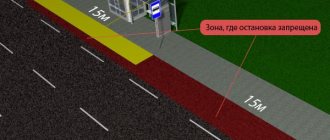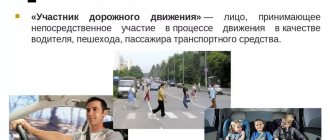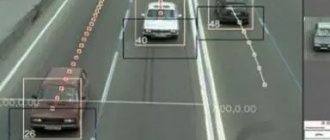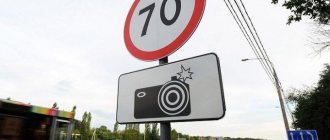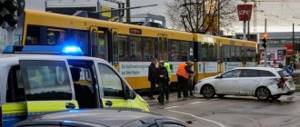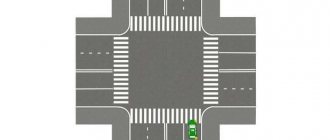The essence of amendments to the traffic rules - new paragraph 2.3.4
By Decree of the Government of the Russian Federation No. 1524 of December 12, 2017 (LINK), a change was made to the traffic rules by adding another paragraph to the text of the Rules - 2.3.4.
Now drivers, in addition to the already existing requirements of Section 2, are required to use a jacket, vest or cape vest with stripes of reflective materials.
The text of the amendments made to the traffic rules:
What should a driver do and what is he entitled to?
MREO traffic police of the Ministry of Internal Affairs for the Republic of Buryatia
When a vehicle is stopped by a traffic police officer, the motorist has the right to communicate with the traffic inspector while being directly in the vehicle itself. In turn, the traffic police officer has the right to demand that the driver leave the car only in certain situations, which include the need to eliminate a technical malfunction of the car or comply with the rules for transporting goods that he violated, or if the driver has characteristic signs of intoxication or illness.
Also, the traffic inspector has the right to demand such actions from the driver in cases where it is necessary to check the numbers of units and components of the car, since the motorist must be directly present during such a procedure. In addition, grounds may include conducting a personal search, providing assistance to other road users if necessary, as well as situations in which the driver’s behavior threatens the safety of the traffic police officer who stopped the vehicle. The remaining rules defining the rights and obligations of a motorist in the event of a vehicle being stopped by a traffic police officer are presented in the following paragraphs:
- Guided by the requirement of the traffic inspector to stop, it is necessary to perform such an action taking into account the current traffic rules, which prohibit performing this at stops, bridges, overpasses and under them, intersections, pedestrian crossings, etc.;
- The driver must move the vehicle after stopping if his car interferes with the movement of other vehicles or the presence of the car on a certain place on the roadway creates a threat to the traffic inspector;
- The driver has the right to find out the reason for stopping the vehicle, as well as obtain information regarding the position of the traffic police officer and his full name and, if necessary, ask to present a certificate;
- When drawing up an administrative protocol, a motorist has the right to demand that a list of persons who were in the car as passengers be included in the document, since their testimony may subsequently be useful to him when trying to protect his rights or in court proceedings;
- Any driver has the right not to incriminate himself. In fact, this means that the motorist may not sign the administrative protocol drawn up if he does not agree with any statements or wording reflected by the traffic police officers. Automatic agreement with the stated violation actually means an admission of guilt and subsequently proving one’s innocence will be problematic;
- After the inspector has drawn up a protocol on an administrative offense, the motorist has the legal right to familiarize himself with its contents, and, in addition, if any phrases or formulations are not entirely clear to him, clarify their meaning or inquire about what specific illegal actions he has taken. imputed;
- The driver has the right to demand a copy of the protocol drawn up by the traffic police officer. In such a situation, it will no longer be possible to supplement its content or partially change it;
- The motorist is obliged to provide, upon request of the traffic police officer, a driver’s license and documents for the vehicle. In case of their absence, the traffic inspector has the right to detain him until the circumstances of the current situation are clarified. In this case, the driver has the right to seek help from third parties so that they deliver documents that were forgotten or left in another place.
Separately, it is worth noting that when performing duties and demanding compliance with their rights, the driver in any situation must behave correctly and avoid obscene language, swearing or aggressive behavior. Otherwise, such actions may be considered as an obstacle to the performance of traffic police officers’ direct duties or as an insult - such facts, even in the absence of traffic violations, will inevitably entail administrative liability and punishment, which will be imposed during the trial.
In what cases is a driver required to wear a reflective vest?
1. In case of a forced stop or an accident.
Let us recall that a forced stop is an unintentional (unplanned) cessation of vehicle movement due to:
- breakdown (technical malfunction);
- danger created by the cargo being transported, an obstacle on the road, or the well-being of the driver and passenger.
An accident is an event that took place while a vehicle was moving along the road, with its participation. In road accidents, people are killed or injured, vehicles, cargo, structures are damaged, or other material damage is caused.
2. When you are on the roadway or side of the road at the time of leaving the car.
The driver must be outside the vehicle - on the side of the road or roadway. This requirement does not apply to the sidewalk and tram tracks (oddly enough!).
3. In the dark or in conditions of limited visibility.
During daylight hours and in conditions of insufficient visibility, this requirement does not apply. (The latter requirement regarding insufficient visibility is by no means indisputable).
4. Outside populated areas.
This rule only applies outside populated areas. That is, a driver in a populated area can wear special clothing only at his own discretion.
It is important to note that the section of road marked with the sign “Beginning of a populated area” (white on blue; 5.25), according to the rules, also refers to sections of roads outside a populated area.
5. After 90 days after publication of the Resolution.
This means only one thing: car owners have a three-month head start to buy either a jacket, a special vest, or a special vest with reflective inserts before the new traffic rules requirement comes into effect.
It is important to note that the driver is required to carry and wear flashing lights if all of the above conditions are present simultaneously .
In other words, if at least one of the conditions of the requirement is not met, the driver is not required to take out and put on special clothing.
Comments to paragraph 2.1.1 of the traffic rules
So, let's start with how exactly it is necessary to present documents to the traffic police inspector for inspection. They need to be submitted for verification - this is directly written in paragraph 2.1.1. This means that it is not enough to simply show them - you need to give them to an employee so that he can study them.
In 90% of all cases, the driver needs to submit only 3 documents:
- a valid driver's license (paragraph 2 of clause 2.1.1 of the Traffic Rules),
- vehicle registration certificate (paragraph 3 - this is the only registration document for 2021),
- OSAGO policy (paragraph 6).
But in some cases other documents will be required:
- transportation permit, if you are currently driving a taxi,
- waybill - if the car is registered to an organization and you are currently carrying out operational activities in this organization: transporting cargo or luggage; if you are simply driving an LLC car, then a waybill is not needed, although in practice traffic police inspectors often and illegally require it,
- if you are driving a special vehicle and transporting dangerous goods, large or heavy, you will also need a permit for such transportation, as well as a license card when it is licensed,
- if the car has a “Disabled Person” sign, then be prepared to present documents confirming it - even if you are transporting a disabled passenger,
- if the car is registered in another state and/or you are participating in international traffic, then clause 2.1.1 of the traffic rules requires that you also have an appropriate permit card, a waybill and documents for the cargo in cases where this is necessary (this is not necessary if you are simply transporting your own luggage and do not carry out commercial transportation).
Do I need to show the PTS?
No. Submission of this document for verification is not provided for in clause 2.1.1.
A vehicle passport is not a registration document; according to Order No. 1001, it is only an STS. For the same reason, PTS cannot replace STS if you suddenly lost the latter.
If the car has just been purchased
Whether it’s a new car or a second-hand car, there is no legal obligation to submit the purchase and sale agreement for inspection. The driver’s responsibilities for the list of documents for inspection are clearly stated in paragraph 2.1.1 of the 2021 Traffic Regulations, and the inspector’s right to demand them is in the Administrative Regulations introduced by Order No. 664.
None of the legal acts of May 20, 2021 require the driver to present a sales contract for inspection by an inspector.
- When purchasing a new car, when checking documents, the driver is only required to hand over his driver’s license.
- When purchasing a used car - a driver's license and vehicle registration certificate.
No matter how paradoxical it may be, this is the law, and this is the law (more precisely, a by-law). But this is all in theory. In practice, inspectors almost always require documents confirming the purchase of the car. And your choice: argue with the inspector (and, most likely, successfully - judicial practice in 2021 is on the driver’s side), or simply carry the DCP with you (but then also the PTS, just in case).
How can I present it to the MTPL insurance company for verification if the policy is electronic?
In this case, the Federal Law “On Compulsory Motor Liability Insurance” and the current traffic regulations oblige the driver to carry with him and submit for verification a printout of electronic insurance.
At the same time, it can be black and white, not necessarily color, it does not need to be certified by the insurance company - just print it out. There is also no indication of the size of the printed insurance - it can be the size of an STS, not necessarily A4 format. But so that the objective side of the offense is not far-fetched, the policy must be completely readable.
About the iron argument
It's illegal, period! Despite numerous disputes on the Internet about the fact that formally the documents were transferred and simply attached to the “argument”, the courts are almost always on the side of the inspector. To confirm this, we present below judicial practice and, even lower, a video about what will happen if you fasten documents into an “iron argument.”
Driver's license categories
In accordance with the courses completed at the driving school and successful exam results, each driver’s license is awarded one or more categories of vehicles that he has the right to drive.
Below is a visual table of categories:
| Category designation | Decoding |
| A | Motorcycles |
| A1 | Small motorcycles and mopeds with a power of up to 11 kW and an engine capacity of 50-125 cm3 |
| IN | Passenger cars with a specific weight of no more than 3.5 tons and a number of common seats no more than 9 |
| IN 1 | Quadricycles and tricycles |
| BE | Passenger cars with trailers not heavier than 750 kilograms |
| WITH | Vehicles heavier than 3.5 tons with the possibility of trailers up to 750 kilograms specific gravity |
| C1 | Vehicles with a specific gravity in the range of 3.5-7.5 tons |
| SE | Category C vehicles with a trailer weighing 750 kg – 3.5 tons |
| C1E | Category C vehicles with a trailer whose specific weight exceeds 750 kilograms, if their total weight does not exceed 12 tons |
| D | Vehicles for transporting passengers with a total seating capacity of more than 9 with permission for a trailer up to 750 kilograms |
| D1 | Cars with a total number of seats 9-17 |
| DE | Category D vehicles with the ability to trailer from 750 kilograms to 3.5 tons |
| D1E | Category DE with the possibility of a trailer, in which the total weight of the vehicle does not exceed 12 tons |
| M | Small-displacement mopeds and other vehicles whose engine capacity does not exceed 50 cm3 |
| Tm | Tram drivers |
| Tb | Trolleybus drivers |
Some categories are worth dwelling on separately.
Class "A"
Classic license for driving motorcycles.
According to paragraph 1.1 of Chapter 1 of the Traffic Regulations, motorcycles include two-, three- and four-wheeled vehicles with the possibility of a side trailer, the specific weight of which does not exceed 400 kilograms.
Class "A1"
It is a subcategory of the previous class and also gives the right to manage similar funds. The difference lies in the limiting technical characteristics described in the table.
If you have category “A”, you do not need to receive this subclass separately - it is assigned automatically.
Rights "B"
Standard category for driving cars of various brands.
Allows driving a passenger car with the possibility of a trailer weighing more than 750 kilograms, but less than the mass of the car. In this case, the mass of both means should not be more than 3.5 tons.
The permit also applies to minibuses and jeeps. The main requirement is compliance with technical specifications.
Subcategory "B1"
A subcategory with the right to drive three- and four-wheeled vehicles with an unladen weight of not more than 550 kilograms.
According to traffic regulations, unladen weight refers to the weight of a fully equipped vehicle, with fuel, lubricants and others, excluding luggage, passengers, driver and battery weight.
Category "C"
This class means driving cargo vehicles that meet the specified technical characteristics, which do not belong to category D.
Possession of these rights prohibits driving light trucks and cars unless this is also stated on your license.
Subcategories "CE" and "C1E"
“CE” cannot be obtained without first opening category “C”. At the same time, if you have received this class, you can freely drive “C1E” vehicles.
"D" certificates
This includes various buses that meet technical specifications.
Having a license in this category, you also have the right to drive the vehicles described in “D1”.
"DE" and "D1E"
The first designation, in addition to vehicles that fit into the specified technical characteristics, also implies articulated buses. In addition, the “DE” subcategory gives automatic permission to open “D1E”.
Rights "M"
This category appeared relatively recently - to open it in your license, it is enough to have the rights of any of the listed classes.
"Tm" and "Tb"
Until recently, the operation of trams and buses did not require the designation of any specific category and was issued in special notes.
